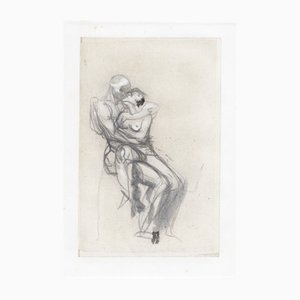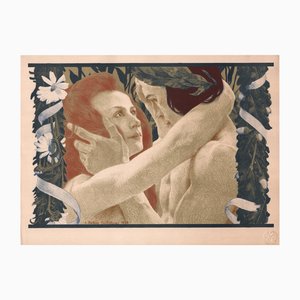Traducción generada automáticamente
Mostrar original
Mostrar traducción
Eugène Trigoulet (1864 - 1910)
Le Chemin de la Mort (The Road to Death)
Original Lithograph from the glorious portfolio "L'Estampe Moderne", issue #15 (July 1898)
On wove paper
Year: 1898
Size (sheet): 305 x 405 mm
Size (image): 224 x 351 mm
Signed "E. Trigoulet" on the plate, bottom right
Blind stamp of the publisher, bottom right, out of the image
Great condition: minor signs of age and handling
Great colours
Full margins (not cropped, not trimmed)
___
About the Collection (L'Estampe Moderne)
L'Estampe Moderne appeared in 1897-1899 as a series of 24 monthly fascicles, each containing 4 original lithographs, printed by Parisian Imprimerie Champenois. Many accomplished European Art Nouveau painters contributed works to this publication, which contained only Original prints invented and produced especially for this collection. The publication was edited by Charles Masson and H. Piazza. Each issue came in a paper cover bearing an original lithograph by Alphonse Mucha.
Each lithograph was accompanied by a tissue containing the details (title of the artwork, name of the artist, etc.) and a short text by a well-known author who inspired the artist (this one being from Le Chant de la Mort, The Song of Death, aka The Dance of Death, one of the earliest stories by Gustave Flaubert and his attempt at Romanticism, which he lately abandoned in favour of Realism).
___
About the artist
Eugène Flavien Trigoulet (1864 - 1910) was a French painter, designer and engraver.
Eugène Trigoulet was admitted to the Beaux-Arts in Paris in 1882, where he attended the classes of Jean-Léon Gérôme , Henri-Léopold Lévy and Albert Maignan. He graduated in 1889 and then applied several times in a row for the Prix de Rome and, after a mention in 1892, finally won the second grand prize for painting in 1893 for a painting based on a theme of Samson: he then left for Villa Medici. In addition to Italy, he visited Brittany, Spain, Algeria and Bruges, bringing back many landscape paintings and studies.
from the late 1880s, he taught painting classes at the art studios of the City of Paris, a position he held until his death.
Trigoulet's style "avoids the pitfall of anecdote thanks to a brutal and schematic style indicating the volumes - boats, carts and people - by large dark masses. He powerfully expresses, in brown and black scales, the harsh life of Norman and Picard fishermen"
(Trigoulet, Eugène, in "Dictionnaire des petits maîtres de la peinture", by Gérald Schurr and Pierre Cabanne, Paris, Éditions de l'amateur, 1996, volume II, page 469, transl.).
___
from the text on the tissue paper, by Flaubert:
J'ai tout vu naître et j'ai tout vu périr! A peine si je compte les brèches que chaque génération apporte sur ma faux. Je suis éternelle comme Dieu, je suis la nourrice du monde qui l'endort chaque soir dans une couche chérie. Toujours mêmes fètes et même travail. Chaque matin je pars, et chaque soir je reviens, tenant dans un pan de mon linceul toute l'herbe que j'ai fauchée, et puis je la jette au vent.
Comme on te respecte, ô Mort, comme on t'adore! Les papes pour t'implorer te jettent leur tiare: les rois, leur sceptre; les peuples, leurs malheurs; les poètes, leur renommée; et tout cela tremble et s'agenouille...
English Translation:
How many nights, and years, and ages have I journeyed thus! A
witness of the universal birth and of a like decay; Innumerable
are the generations I have garnered with my scythe. Like God, I am
eternal! The nurse of Earth, I cradle it each night upon a bed
both soft and warm. The same recurring feasts; the same unending
toil! Each morning I depart, each evening I return, bearing within
my mantle's ample folds all that my scythe has gathered. And then
I scatter them to the four winds of Heaven!
...
All men respect thee; nay, adore thee! To invoke thy favour, popes offer thee their triple crowns, and kings their sceptres; peoples, their secret sorrows; poets, their renown. All cringe and kneel before thee, yet thou rushest on over their prostrate forms.
___
Important:
. The listing is for the original print, in the above mentioned very good / excellent condition.
. The original tissue paper introduction has some folds and tears, especially along the margins, and it will be given as is to the buyer as a gift for confirming the authenticity.
. The cover by Mucha is shown as a reference: a high quality picture will be given on request and, eventually, it is possible to purchase the cover on another listing (same to the other three plates of the issue)
Eugène Trigoulet (1864 - 1910)
Le Chemin de la Mort (El camino de la muerte)
Litografía original de la gloriosa carpeta "L'Estampe Moderne", número 15 (julio de 1898)
Sobre papel tejido
Año: 1898
Tamaño (hoja): 305 x 405 mm
Tamaño (imagen): 224 x 351 mm
Firmado "E. Trigoulet" en la plancha, abajo a la derecha
Sello ciego del editor, abajo a la derecha, fuera de la imagen
Buen estado: pequeños signos de envejecimiento y manipulación
Gran colorido
Márgenes completos (no recortados)
___
Acerca de la colección (L'Estampe Moderne)
L'Estampe Moderne apareció en 1897-1899 como una serie de 24 fascículos mensuales, cada uno con 4 litografías originales, impresos por la Imprimerie Champenois de París. Numerosos pintores europeos del Art Nouveau contribuyeron con obras a esta publicación, que sólo contenía grabados originales inventados y producidos especialmente para esta colección. La edición corrió a cargo de Charles Masson y H. Piazza. Cada número se presentaba en una cubierta de papel con una litografía original de Alphonse Mucha.
Cada litografía iba acompañada de un pañuelo de papel con los detalles (título de la obra, nombre del artista, etc.) y un breve texto de un autor conocido que inspiró al artista (éste es de Le Chant de la Mort, El canto de la muerte, alias La danza de la muerte, uno de los primeros relatos de Gustave Flaubert y su intento de romanticismo, que abandonó más tarde en favor del realismo).
___
Sobre el artista
Eugène Flavien Trigoulet (1864 - 1910) fue un pintor, diseñador y grabador francés.
Eugène Trigoulet ingresó en las Bellas Artes de París en 1882, donde asistió a las clases de Jean-Léon Gérôme , Henri-Léopold Lévy y Albert Maignan. Se gradúa en 1889, se presenta varias veces consecutivas al Prix de Rome y, tras una mención en 1892, gana finalmente el segundo gran premio de pintura en 1893 por un cuadro basado en un tema de Sansón: se marcha entonces a Villa Médicis. Además de Italia, visitó Bretaña, España, Argelia y Brujas, trayendo de vuelta numerosos cuadros de paisajes y estudios.
desde finales de la década de 1880, impartió clases de pintura en los estudios de arte del Ayuntamiento de París, cargo que ocupó hasta su muerte.
El estilo de Trigoulet "evita el escollo de la anécdota gracias a un estilo brutal y esquemático que indica los volúmenes -barcos, carros y personas- mediante grandes masas oscuras. Expresa con fuerza, en escamas marrones y negras, la dura vida de los pescadores normandos y picardo"
(Trigoulet, Eugène, en "Dictionnaire des petits maîtres de la peinture", de Gérald Schurr y Pierre Cabanne, París, Éditions de l'amateur, 1996, tomo II, página 469, trad.).
___
del texto del papel de seda, de Flaubert:
¡J'ai tout vu naître et j'ai tout vu périr! A peine si je compte les brèches que chaque génération apporte sur ma faux. Je suis éternelle comme Dieu, je suis la nourrice du monde qui l'endort chaque soir dans une couche chérie. Toujours mêmes fètes et même travail. Chaque matin je pars, et chaque soir je reviens, tenant dans un pan de mon linceul toute l'herbe que j'ai fauchée, et puis je la jette au vent.
¡Comme on te respecte, ô Mort, comme on t'adore! Les papes pour t'implorer te jettent leur tiare: les rois, leur sceptre; les peuples, leurs malheurs; les poètes, leur renommée; et tout cela tremble et s'agenouille...
Traducción al inglés:
¡Cuántas noches, años y edades he viajado así! A
testigo del nacimiento universal y de una decadencia similar; Innumerables
son las generaciones que he cosechado con mi guadaña. Como Dios, soy
eterno Nodriza de la Tierra, la acuno cada noche en un lecho
suave y cálido. Las mismas fiestas recurrentes; el mismo interminable
sin fin Cada mañana parto, cada tarde regreso, llevando dentro
los amplios pliegues de mi manto todo lo que mi guadaña ha recogido. Y entonces
Los esparzo a los cuatro vientos del cielo
...
Todos los hombres te respetan; es más, ¡te adoran! Para invocar tu favor, los papas te ofrecen sus coronas triples y los reyes sus cetros; los pueblos, sus penas secretas; los poetas, su renombre. Todos se encogen y se arrodillan ante ti, pero tú te precipitas sobre sus formas postradas.
___
Importante:
. El listado es para la impresión original, en el estado mencionado muy bueno / excelente.
. La introducción de papel de seda original tiene algunos pliegues y rasgaduras, especialmente a lo largo de los márgenes, y se dará tal cual al comprador como un regalo para confirmar la autenticidad.
. La portada de Mucha se muestra como referencia: se entregará una fotografía de alta calidad a quien la solicite y, eventualmente, es posible adquirir la portada en otro anuncio (al igual que las otras tres láminas de la edición)




















Contacta con nosotros
Haz una oferta
¡Hemos notado que eres nuevo en Pamono!
Por favor, acepta los Términos y condiciones y nuestra Política de privacidad
Contacta con nosotros
Haz una oferta
¡Ya casi está!
Para seguir la conversación en la plataforma, por favor completa el registro. Para proceder con tu oferta en la plataforma, por favor completa el registro.Exitoso
Gracias por tu consulta, alguien de nuestro equipo se pondrá en contacto contigo en breve.
Si eres profesional del diseño, por favor solicita aquí los beneficios del Programa comercial de Pamono